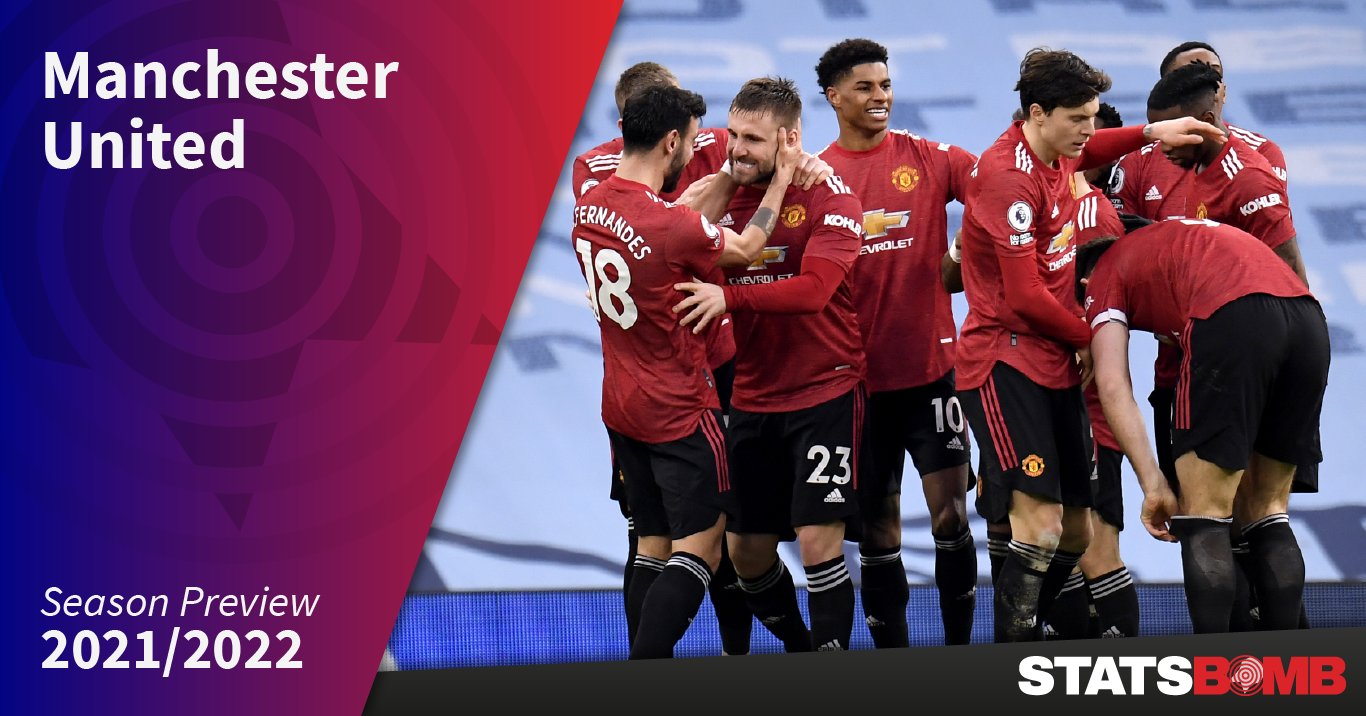By post-Ferguson standards, Premier League runners-up and Europa League finalists amounted to a good season for Manchester United in 2020/21.
Ultimately there were no trophies, but 'progress' has been the watchword for a few years now, and there have been signs of it both on and off the pitch. United’s trendline since the start of the 2018/19 season makes for pretty good viewing – attacking and defensive numbers have both been moving in the right direction for the most part.
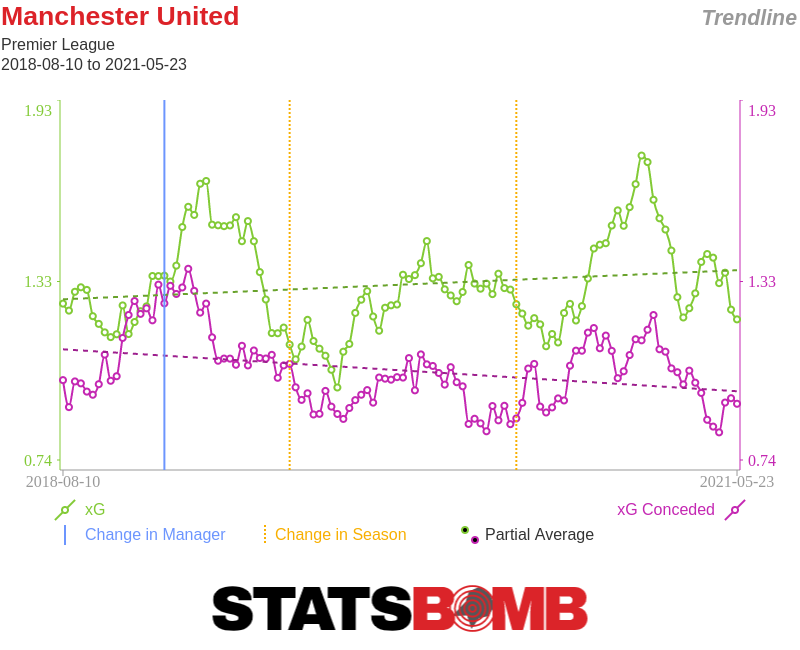
However, a fairly distant second to a brilliant Manchester City is perhaps less impressive given the problems faced by United’s top four bedmates – a Liverpool without their three top choices at centre back, and a Chelsea that only really hit their stride after Tuchel arrived and turned them into champions of Europe. We are starting next season with the top end of the league in a very different spot; that makes United’s prospects less enticing.
Even with the problems endured by Chelsea and Liverpool, United were some way off the other Champions League qualifiers in terms of expected goal (xG) difference per game. Our numbers have them at +0.33 xGD per game to City’s +1.12, Liverpool’s +0.76, and Chelsea’s +0.70. Enough for fourth-best in the league, but still some way off the other three and you also have to factor in that United spent a good portion of the season chasing down 1-0 deficits, which could have inflated their underlying numbers slightly. All other things being equal, the gap between United and their top-four rivals could increase even more with their rivals starting in better spots than they were for much of last season.
There is, however, the small issue of the transfer window. Much will depend on whether or not the new signings can solve some of the issues that have plagued United for some time now. The over-reliance on the left side in build-up seems to be one of the issues United are trying to solve in this window with the signing of Jadon Sancho and fairly loud noises about Kieran Trippier. Likewise, the issue of depth at centre-back, with Eric Bailly’s injury proneness and Axel Tuanzebe’s youth, has been addressed in the way that issues of depth should be – by strengthening the first team. The addition of Eric Ramsay as a first-team coach who’ll be in charge of set-plays will also serve as music to the ears of this article's readership.
The Goalkeeper Dilemma(?)
One question United don’t appear to be trying to answer in the transfer window (despite Tom Heaton having a pretty stellar pre-season thus far) is: who is the first-choice keeper?
United spent most of last season with two keepers in direct competition for the first-choice berth. As always, competition for places should really fall into the ‘nice problem to have’ category. It's not something we often see when it comes to goalkeepers. From the outside, it seems that the most important factors in the decision are not things that can be measured directly: how comfortable the defenders are with the keeper, player morale, maintaining David de Gea's value for a future sale, the extent to which having to oust de Gea motivates Dean Henderson -- all of these human and managerial factors that football managers have to contend with and we don't have to worry about. There is not much in it from a playing point of view, so it’s all about the best way to manage the handover as far as I'm concerned.
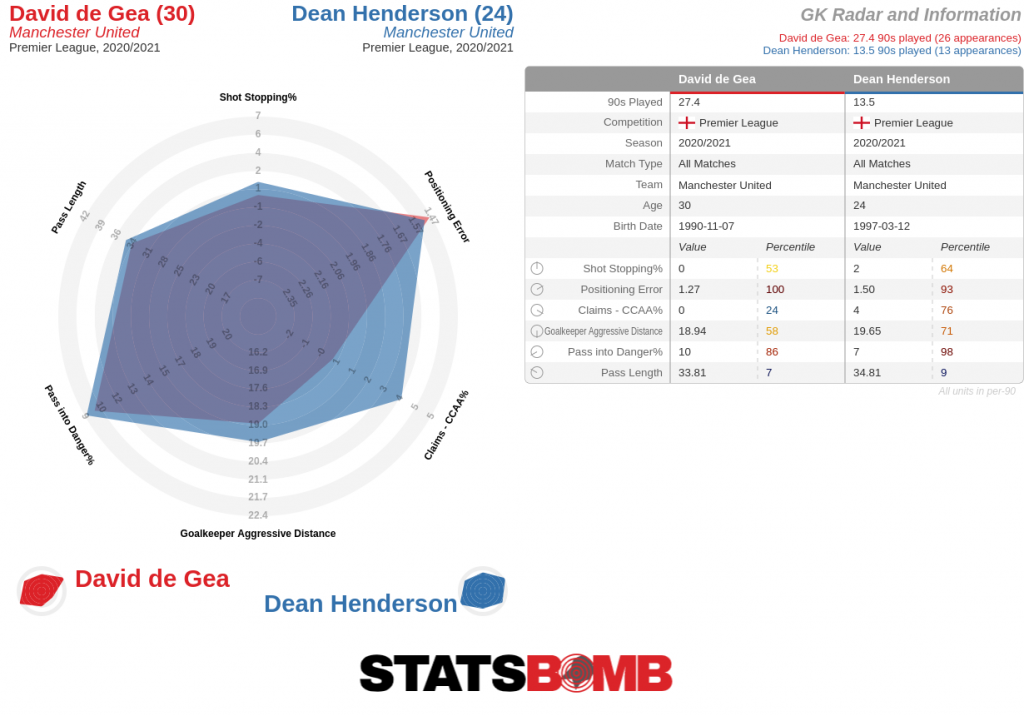
Henderson was more aggressive in coming to get the ball, claiming the ball roughly 4% more than expected based on the crosses he faced. That is the only stark difference between Henderson and de Gea on these metrics -- they both had excellent positioning (measured by their average distance from a typical keeper location), distributed the ball similarly in terms of pass length and in finding free men, and were more-or-less average in terms of shot-stopping relative to post-shot xG. The minor differences here are pretty paltry relative to season-to-season variability.
Having the opportunity to bed Henderson in while also giving de Gea firm competition over the course of a season is a big luxury. The succession plan looked like it might be reaching completion towards the end of last season, so it will be interesting to see who is breathing down whose neck come the season's start.
Set-Pieces
United have clearly identified set-pieces as an area that can be improved. Eric Ramsay joins from Chelsea U23s as a young coach with a very good reputation and has reportedly been tasked with overhauling United’s set-pieces.
Their performance last season wasn’t terrible, but it was close to average, and set-pieces are an element of the game where focused work can pay real dividends in terms of goals and league standing.
What sort of impact could Ramsay have? A realistic objective is to get close to the top teams' set-piece efficiency of last season.
Let’s say United improve their xG/Set Piece from 0.0062 to 0.0082, and xG/Set Piece Conceded from 0.0064 to 0.0044, putting them about halfway between Everton and Man City on the scatter plot below. That’s an improvement of 0.2% of a goal for each set-piece conceded and taken. It doesn’t sound like much, but considering that teams take about 35 set-pieces in every game and concede about the same, improvements at both ends of the pitch would add up over a season.
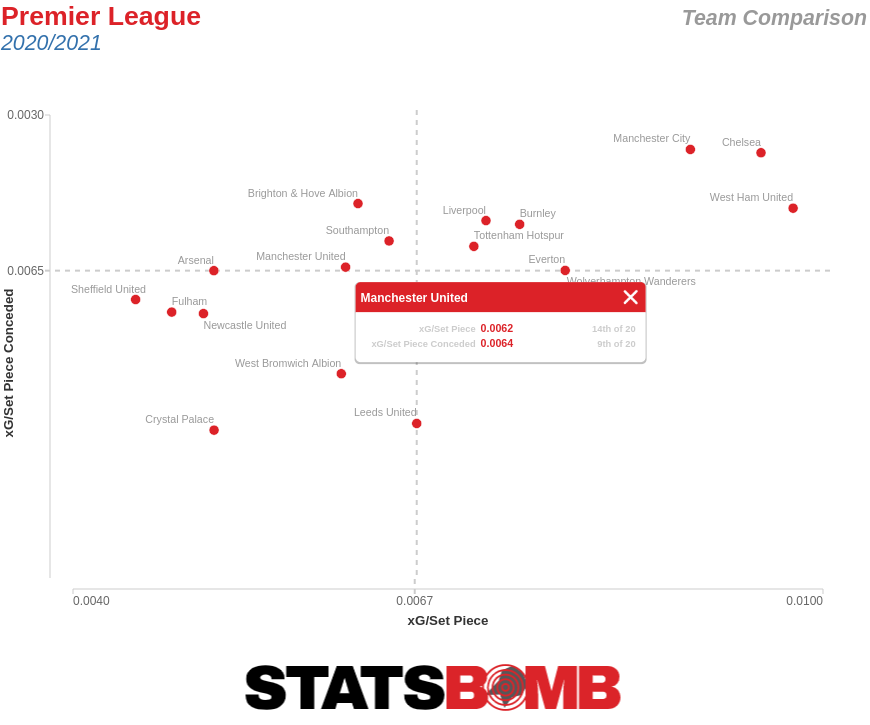
That means United could (optimistically, but not fancifully) improve their xG difference per game by about 0.14 through set-pieces alone, a number that would make up about 38% of the gap between them and Chelsea. That kind of impact is really hard to achieve through player signings unless you’re spending big bucks on an upgrade to a current starter. This back-of-the-envelope calculation points towards a shrewd bit of business, as long as Ramsay can get United to somewhere near league-best.
Jadon Sancho
In signing Sancho, United have obtained one of the most exciting young prospects in world football, and in a position where they've been lacking for many years. According to StatsBomb's player similarity tool, the most similar players to Sancho in the top 5 leagues last season were Ousmane Dembélé, Christian Pulisic, Leroy Sané, Samuel Chukwueze, and United's own Marcus Rashford, who spent a good deal of time on the right last season. These are all quick, technically gifted wide players with an eye for goal.
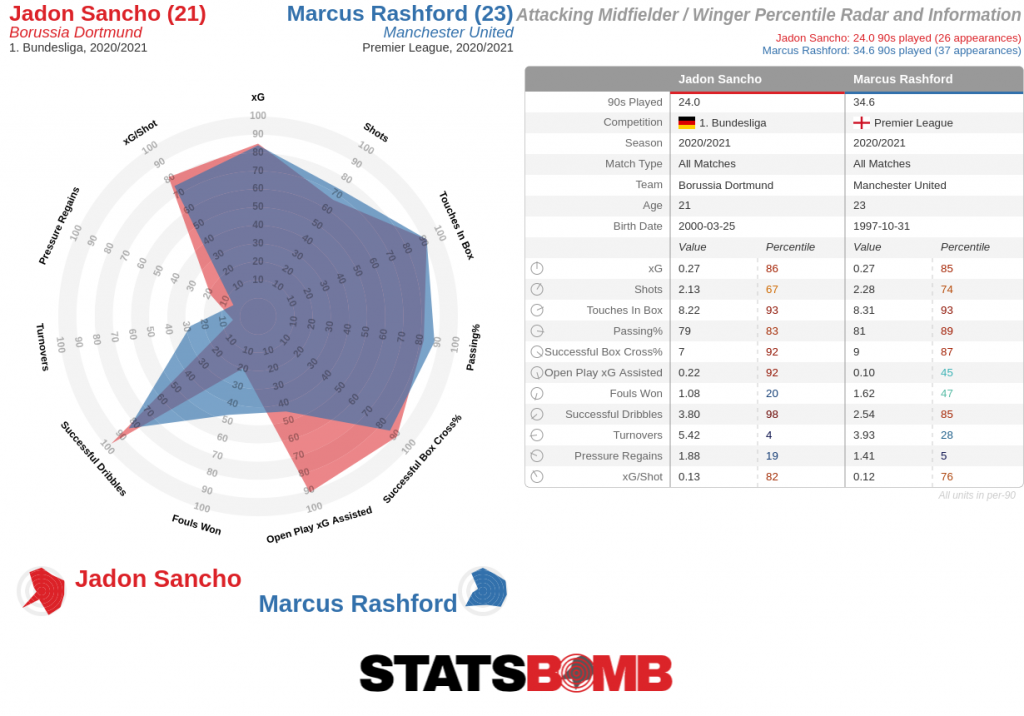
Where Sancho stands out from these players (barring Dembélé) is in his creative output. 0.22 xG assisted from open play last season puts Sancho 19th of wingers in Europe's top 5 leagues. Having Erling Haaland to play those passes to is not a luxury Sancho will be afforded at United (unless...?) and, in their current incarnation, United are a bit less dominant in a typical league game than Dortmund. I'd expect his creative output to drop slightly, but he undoubtedly adds tremendous quality to an already exciting United attack.
There is always a question about whether a player will gel with a new team, but some of the personal issues players can face when moving to the Premier League are not really there for Sancho. He speaks the language, grew up with the league, knows lots of United players already, and knows Manchester. There won’t be much time to settle, coming straight off the back of the Euros, but I don’t see that being a problem despite the inevitable overreactions (including from me!) in the early stages of the season, good or bad. Right now, this looks a fantastic piece of business.
The left-hand side
Pre-Sancho, United's attack skewed towards the left-hand side. Here are their most over-represented pass clusters last season compared to the rest of the league:
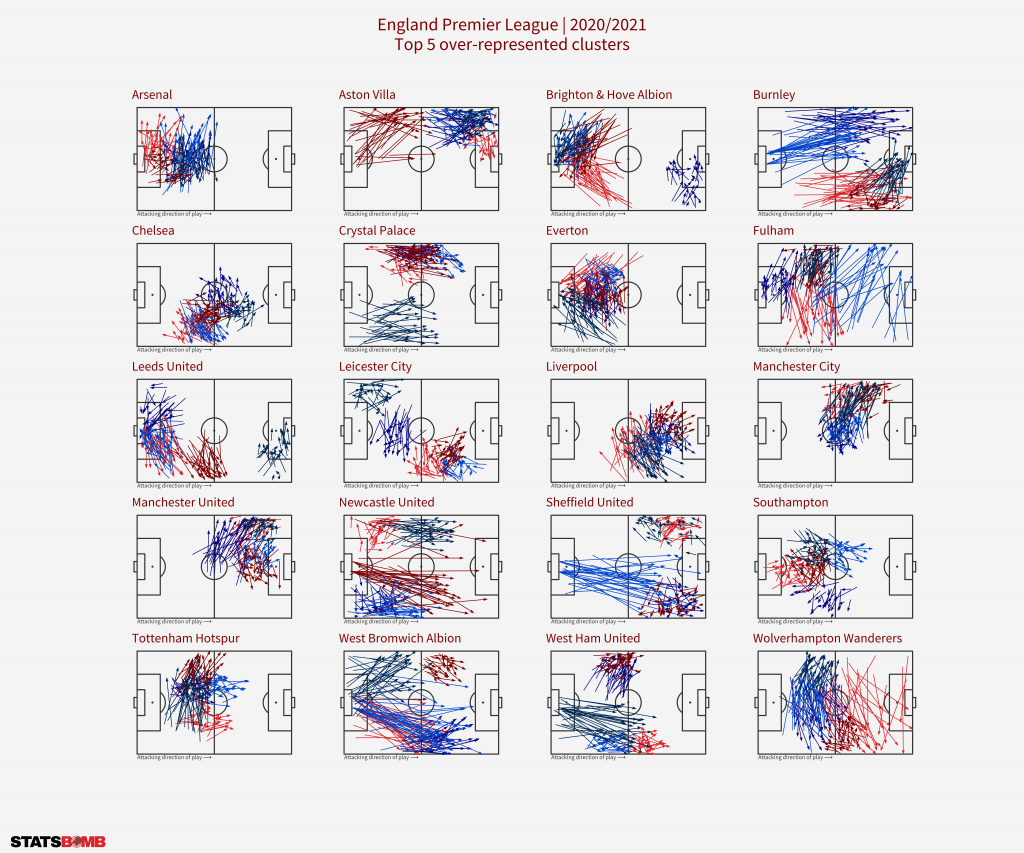
Notice how similar the top-four teams look in terms of their most over-represented clusters. They all favour one side, and they all favour short-ish passes in the opposition half. There is not much getting away from this as a dominant side in the Premier League, and United clearly favoured the left flank.
This tendency is also borne out in United’s possession value. StatsBomb’s new possession value model, On-Ball Value (OBV), estimates the extent to which an action improves a team's expected goal difference over the next two possessions. Looking at the figure below, it's clear that United were strongest down the left (relative to the other teams in the league). That over-represented zone was bearing fruit.
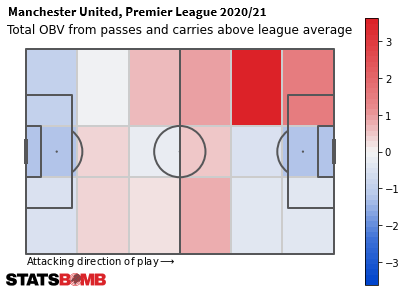
The corresponding area on the right looks pretty barren by comparison, with United only producing at around league average from there. Sancho should help to turn some of those zones red, but that will, in turn, have an impact on usage – Bruno Fernandes will carry less of the creative burden, and the left side probably won’t be favoured quite so heavily. It’ll be interesting to see how this map has changed by the end of the new season.
The midfield
Another area of the pitch in which many fans and pundits believe United needs reinforcements is central midfield. The general rationale for this is that United’s attacking talent might be better suited to a system where both Paul Pogba and Fernandes play centrally in front of a single, more defensively minded midfielder. The typical concerns are that neither Scott McTominay nor Fred can cover for them on their own, Nemanja Matić is unable to play enough minutes, and Pogba’s defensive tendencies aren’t well-suited to playing in the midfield two in the current set-up.
Finding this miracle player to unlock the ‘Silva & de Bruyne’ style of play that I think people are envisaging is not an easy task, so I expect we’ll see something somewhat similar to last season in terms of the composition of the midfield. Matic can still offer a lot in short spells, but it’ll be Fred, McTominay and Pogba who mostly share the two midfield berths.
But what is the state of the ‘McFred double pivot’? Using Statsbomb 360 data, we can look at how often players break lines with their passing. We define a line-breaking pass as any pass that:
- successfully progresses the ball at least 10% closer to goal…
- …and either splits two opposition defenders or ends in the space behind them, provided that the defenders are less than 5m apart vertically.
We filter to passes that are completed and that break a line in the opposition half, then normalise per 90: the results make Matic’s lack of mobility and inability to accrue significant minutes all the more annoying. He ranked fourth in this metric among PL midfielders with >900 minutes last season, bettered only by Thiago, Mateo Kovačić, and Fernandinho. Fred was 13th of 73, McTominay 26th.
These numbers are fine but probably not quite at the level United need. That said, Paul Pogba’s presumably increased minutes this season should help substantially with progression from midfield (provided he sticks around, of course).
We can look at a simple model of pass availability to explore this a bit more. We start by drawing defensive cover shadows that look like this:
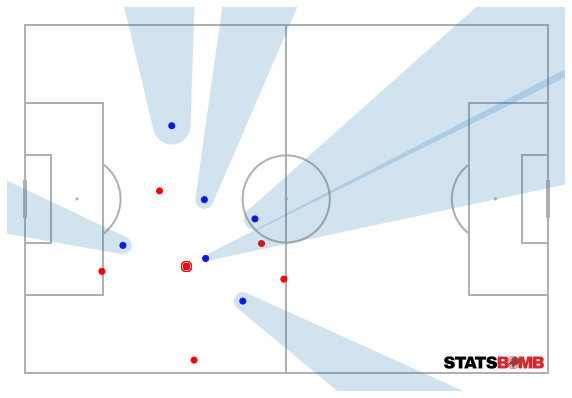
Attacking players who are not in a cover shadow are classed as ‘available’. If they are located 10% closer to the opposition goal than the ball, they are classed as a ‘progressive option’. Then we can look at the percentage of the time a player takes a progressive option when it’s available to get some idea of passing aggression.
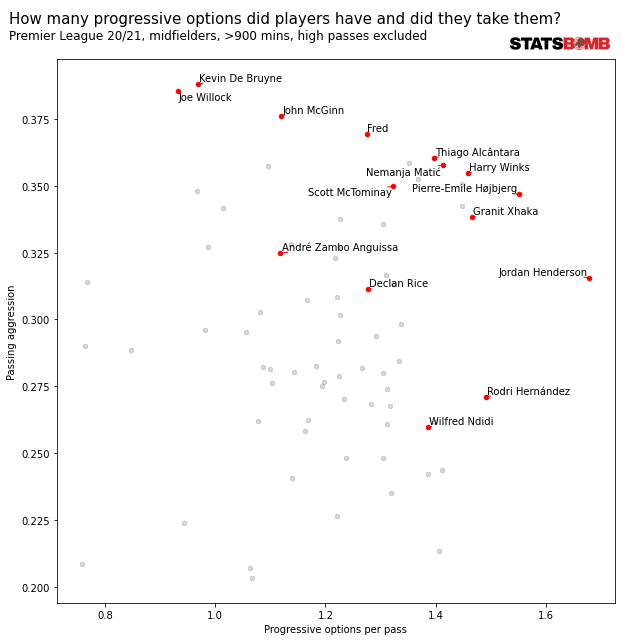
This approach comes with many caveats, and a better way to do this would be with a 360-based possession value model combined with a 360-based expected pass model. However, we aren’t quite there yet, so for now, we’ll proxy expected passes with ‘availability’ and possession value with ‘progression’. Also, we’re only looking at the frame in which the pass was played, so it could be that players are turning down progressive passes before allowing the opposition to block lanes, which makes it look like the option was not there by the time the ball is released.
All that said, we can see that some of the criticism levelled at McTominay’s progressive passing is perhaps unwarranted – movement ahead of him gives him a decent number of options to play progressive passes, and the data suggests he attempts to do so at a reasonable frequency. He is in the company of the more aggressive progressive passers in the league from deeper in midfield when it comes to attempting progressive passes. However, his technical ability and accuracy let him down, and he’s not massively proficient at completing line-breaking passes or progressing the ball overall.
Parting thoughts
United have been making steady progress in their underlying numbers for a few years and have strengthened substantially in attack and defence in this window. The bookies envisage the return of an established top four, with United the least-favoured of those sides, an assessment that seems about right. The new signings and appointments should make up some of the fairly substantial gap between United and their top four rivals from last season, but probably not to the extent that we’ll see them in title contention come the end of the campaign.
Lastly, I can’t finish this article without mentioning the cultural impact that Marcus Rashford is having and at 23 years of age. Whatever happens this season, he is a beacon of light.
Want to read about another team? The rest of our Premier League season previews can be found here
If you're a club, media or gambling entity and want to know more about what StatsBomb can do for you, please contact us at Sales@StatsBomb.com
We also provide education in this area, so if this taste of football analytics sparked interest, check out our Introduction to Football Analytics course
Follow us on Twitter in English and Spanish and also on LinkedIn
